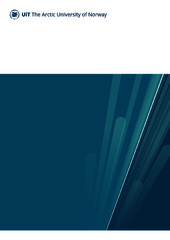| dc.contributor.advisor | Hoff, Bjarte | |
| dc.contributor.author | Al-Sallami, Hussein | |
| dc.date.accessioned | 2023-06-23T09:23:12Z | |
| dc.date.available | 2023-06-23T09:23:12Z | |
| dc.date.embargoEndDate | 2028-07-07 | |
| dc.date.issued | 2023-07-07 | |
| dc.description.abstract | Wireless power transfer can provide the convenience of automatic charging while the ships or maritime vehicles are docking, mooring, or in a sailing maneuver. It can address the challenges facing conventional wired charging technologies, including long charging and queuing time, wear and tear of the physical contacts, handling cables and wires, and electric shock hazards. Capacitive power transfer (CPT) is one of the wireless charging technologies that has received attention in on-road electric vehicle charging applications. By the main of electric fields, CPT offers an inexpensive and light charging solution with good misalignment performance. Thus, this study investigates the CPT system in which air and water are the separation medium for the electrical wireless charging of small ships and unmanned maritime vehicles.
Unlike on-road charging applications, air or water can be utilized as charging mediums to charge small ships and unmanned maritime vehicles. Because of the low permittivity of the air, the air-gapped capacitive coupling in the Pico Farad range requires a mega-hertz operating frequency to transfer power over a few hundred millimeters. This study examines an air-gapped CPT system to transfer about 135 W at a separation distance of 50 mm, a total efficiency of approximately 83.9%, and a 1 MHz operating efficiency. At 13.56 MHz, the study tested a shielded air-gapped CPT system that transfers about 100 W at a separation distance of 30 mm and a total efficiency of about 87%. The study also examines the underwater CPT system by submerging the couplers in water to increase the capacitive coupling. The system can transfer about 129 W at a separation distance of 300 mm, a total efficiency of aboutapproximately%, and a 1.1 MHz operating efficiency. These CPT systems can upscale to provide a few kW for small ships and unmanned maritime vehicles. But they are still facing several challenges that need further investigations. | en_US |
| dc.description.doctoraltype | ph.d. | en_US |
| dc.description.popularabstract | Wireless power transfer can provide the convenience of automatic charging while the ships or maritime vehicles are docking, mooring, or in a sailing maneuver. It can address the challenges facing conventional wired charging technologies, including long charging and queuing time, wear and tear of the physical contacts, handling cables and wires, and electric shock hazards. Capacitive power transfer (CPT) is one of the wireless charging technologies that has received attention in on-road electric vehicle charging applications. By the main of electric fields, CPT offers an inexpensive and light charging solution with good misalignment performance. Thus, this study investigates the CPT system in which air and water are the separation medium for the electrical wireless charging of small ships and unmanned maritime vehicles. | en_US |
| dc.identifier.isbn | 978-82-7823-249-1 | |
| dc.identifier.isbn | 978-82-7823-250-7 | |
| dc.identifier.uri | https://hdl.handle.net/10037/29473 | |
| dc.language.iso | eng | en_US |
| dc.publisher | UiT Norges arktiske universitet | en_US |
| dc.publisher | UiT The Arctic University of Norway | en_US |
| dc.relation.haspart | <p>Paper J1: Mahdi, H., Hoff, B. & Østrem, T. (2023). A Review of Power Converters for Ships Electrification. <i>IEEE Transactions on Power Electronics, 38</i>(4), 4680 - 4697. Published version not available in Munin due to publisher’s restrictions. Published version available at <a href=https://doi.org/10.1109/TPEL.2022.3227398>https://doi.org/10.1109/TPEL.2022.3227398</a>. Accepted manuscript version available in Munin at <a href=https://hdl.handle.net/10037/28579>https://hdl.handle.net/10037/28579</a>.
<p>Paper J2: Mahdi, H., Hattori, R., Hoff, B., Uezu, A. & Akiyoshi, K. Design Considerations of Capacitive Power Transfer Systems. (Submitted manuscript). Now published in <i>IEEE Access, 2023, 11</i>, 57806 – 57818, available at <a href=https://doi.org/10.1109/ACCESS.2023.3283908>https://doi.org/10.1109/ACCESS.2023.3283908</a>.
<p>Paper J3: Mahdi, H., Hoff, B., Ellingsen, P.G. & Østrem, T. (2022). Conformal Transformation Analysis of Capacitive Wireless Charging. <i>IEEE Access, 10</i>, 105621-105630. Also available in Munin at <a href=https://hdl.handle.net/10037/27044>https://hdl.handle.net/10037/27044</a>.
<p>Paper J4: Mahdi, H., Hoff, B. & Østrem, T. (2021). Optimal solutions for underwater capacitive power transfer. <i>Sensors, 21</i>(24), 8233. Also available in Munin at <a href=https://hdl.handle.net/10037/24041>https://hdl.handle.net/10037/24041</a>.
<p>Paper C4: Mahdi, H., Hattori, R., Hoff, B. & Østrem, T. Under seawater Capacitive Power Transfer for Maritime Charging Applications. (Manuscript). | en_US |
| dc.rights.accessRights | embargoedAccess | en_US |
| dc.rights.holder | Copyright 2023 The Author(s) | |
| dc.rights.uri | https://creativecommons.org/licenses/by-nc-sa/4.0 | en_US |
| dc.rights | Attribution-NonCommercial-ShareAlike 4.0 International (CC BY-NC-SA 4.0) | en_US |
| dc.subject | Wireless charging | en_US |
| dc.subject | Small ships | en_US |
| dc.subject | Unmanned maritime vehicles | en_US |
| dc.subject | Capacitive power transfer | en_US |
| dc.subject | Capacitive coupling | en_US |
| dc.title | Capacitive power transfer for maritime electrical charging applications | en_US |
| dc.type | Doctoral thesis | en_US |
| dc.type | Doktorgradsavhandling | en_US |


 English
English norsk
norsk

